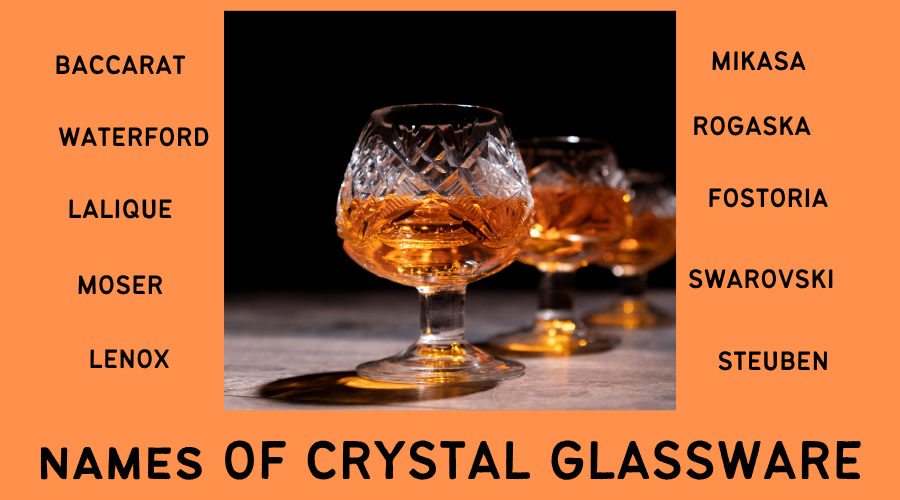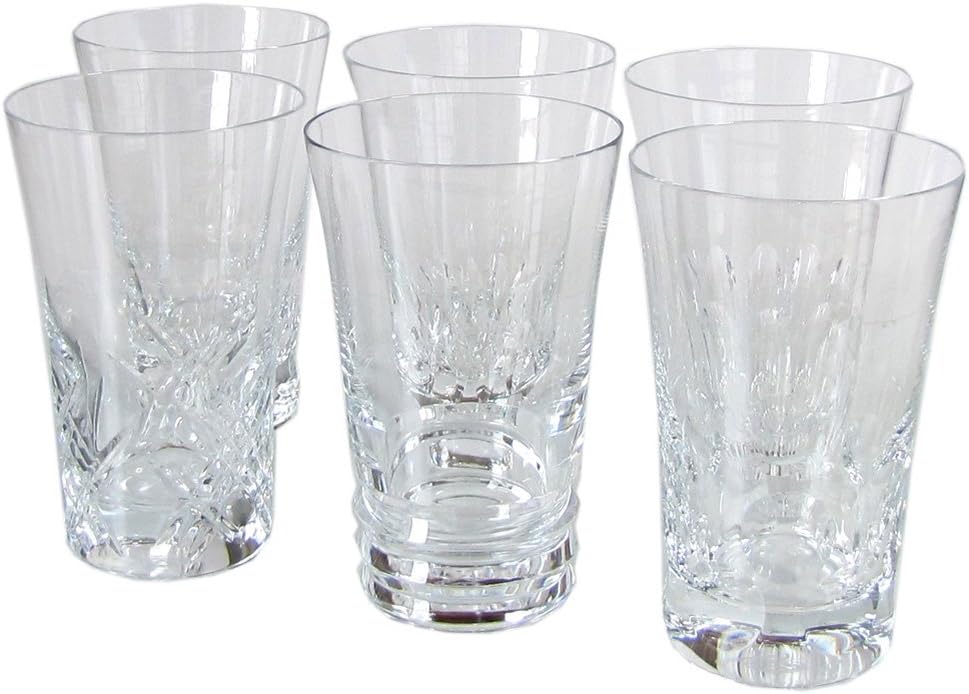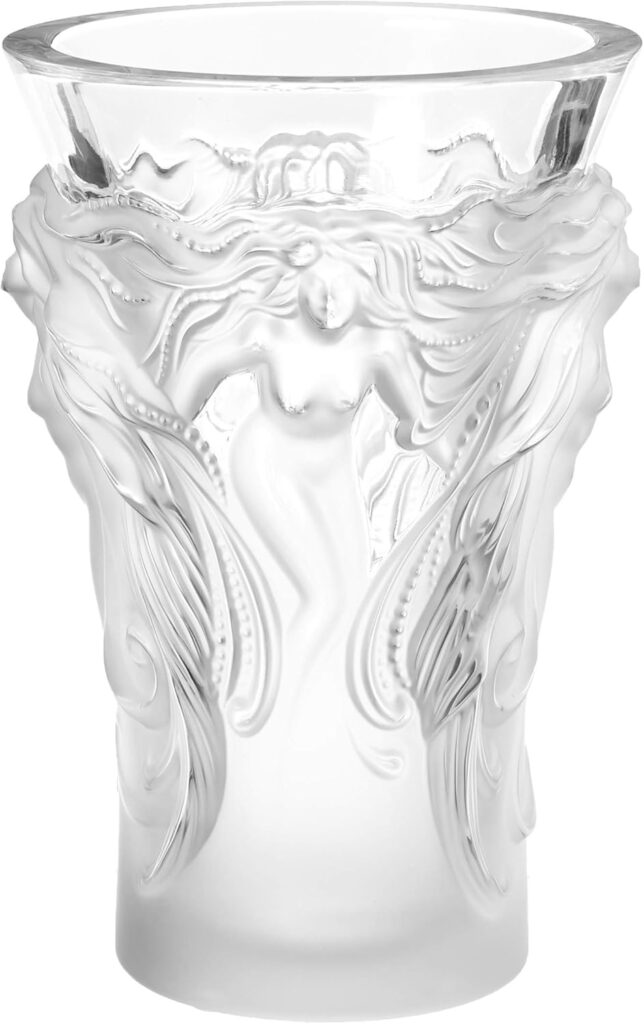You’re at a fancy restaurant and the waiter asks if you’d like your wine in a Bordeaux glass or a Burgundy glass.
Or maybe you’re shopping online and keep seeing terms like “highball,” “tumbler,” and “snifter,” but have no idea what they look like. Sound familiar?
Don’t worry, you’re not alone in feeling confused by all these fancy glass names. Learning the names of crystal glassware doesn’t have to be scary or complicated.
Once you know the basic names and what each glass is used for, you’ll feel much more confident whether you’re shopping, entertaining guests, or just trying to set your table properly.
The good news is that most crystal glassware brand names are pretty simple once you understand what they mean.
Each name usually tells you something about the glass’s shape, size, or what drink it’s meant for.
Let’s break down the most common ones you’ll use in real life.
THE ART OF CRYSTAL NOMENCLATURE: WHY NAMES MATTER
Crystal glassware names aren’t merely decorative labels; they’re roadmaps to history, craftsmanship, and value.
Each name tells a story, sometimes of the artisan who created the design, the region where it originated, or the technique used to achieve its distinctive appearance.
Understanding these names serves multiple purposes for the discerning collector:
Authentication and Investment Protection: Knowing the proper terminology helps you identify genuine pieces and avoid costly mistakes.
A true Baccarat “Harcourt” tumbler carries significantly more value than a well-made imitation.
Historical Appreciation: Many crystal names honour centuries-old traditions. Waterford’s “Lismore” pattern, for instance, pays homage to the Irish castle town where the company’s founders once lived.
Collecting Strategy: Familiarity with naming conventions helps you build cohesive collections and understand which pieces complement one another.
NAMES OF CRYSTAL GLASSWARE MANUFACTURER BRANDS

Before diving into specific patterns, it’s essential to understand that the names of crystal glassware begin with the manufacturers themselves.
These brand names represent centuries of craftsmanship and serve as the foundation of any crystal discussion.
Luxury Crystal House Names
The Elite Tier: These names command immediate respect in crystal circles:

- Baccarat (France): The undisputed king of crystal, synonymous with perfection since 1764

- Waterford (Ireland): Ireland’s crystal ambassador to the world

- Lalique (France): Where art meets functionality in perfect harmony

- Swarovski (Austria): Precision-cut brilliance that captures light like no other
- Steuben (USA): America’s answer to European crystal excellence
The Artistic Innovators: Names that push creative boundaries:

- Orrefors (Sweden): Scandinavian minimalism meets crystal artistry
- Kosta Boda (Sweden): Bold, contemporary designs that challenge convention
- Daum (France): Masters of pâte de verre technique
- Moser (Czech Republic): Bohemian tradition with jewel-toned brilliance
Mid-Range Quality Names
These manufacturer names offer excellent quality without the premium price:

- Lenox (2020 – Present Outside the USA): Elegance and reliability
- Mikasa (Japan): International appeal with consistent quality
- Rogaska (Slovenia): European tradition at accessible prices
- Villeroy & Boch (Germany): Germanic precision in crystal form

- Schott Zwiesel (Germany): Innovation meets durability
Collectible American Names
Vintage American manufacturers whose names now command collector attention:
- Fostoria: The “America’s Crystal” legacy lives on in vintage pieces
- Cambridge Glass: Mid-century American elegance
- Heisey: Distinctive pressed glass patterns from Ohio’s crystal heritage
PRESTIGIOUS CRYSTAL HOUSES AND THEIR SIGNATURE PATTERNS
Waterford Crystal: Irish Heritage in Every Name
Waterford Crystal remains synonymous with luxury, and their naming convention reflects deep Irish roots. The company’s most celebrated patterns carry names that resonate with Celtic history:
- Lismore: Perhaps the most iconic Waterford pattern, named after the historic Irish town
- Colleen: Celebrating Irish femininity with delicate, flowing lines
- Powerscourt: Honouring the magnificent Irish estate and gardens
- Araglin: Named after a river in County Cork
Each Waterford piece bears the signature deep cuts and brilliant clarity that made Irish crystal famous worldwide.
The company’s commitment to traditional mouth-blowing and hand-cutting techniques ensures that every piece bearing these names meets exacting standards.
Baccarat: French Elegance Personified
Baccarat crystal represents the pinnacle of French luxury glassmaking. Their naming system often reflects aristocratic heritage and architectural grandeur:
- Harcourt: The company’s most prestigious line, created for King Louis-Philippe
- Massena: Named after Napoleon’s marshal, featuring bold geometric cuts
- Vega: A contemporary design that bridges classical and modern aesthetics
- Harmonie: Embodying perfect balance in both name and form
The weight and clarity of authentic Baccarat pieces make them immediately recognisable to trained eyes, whilst their names evoke the grandeur of French palaces and châteaux.
Lalique: Art Nouveau Artistry
René Lalique’s legacy lives on through crystal pieces that blur the line between functional glassware and fine art. Lalique names often reflect nature and feminine beauty:
- Bacchantes: Featuring dancing nymphs in relief
- Serpent: Showcasing the sinuous curves of stylised snakes
- Hirondelles: Celebrating swallows in flight
- Feuilles: Capturing the delicate beauty of leaves.
UNDERSTANDING CRYSTAL GLASSWARE TERMINOLOGY
Technical Terms Every Collector Should Know
Mastering the vocabulary of crystal glassware elevates your appreciation and helps you communicate effectively with dealers and fellow collectors:
| Term | Definition | Example |
| Lead Crystal | Glass containing at least 24% lead oxide | Waterford, Baccarat |
| Full Lead Crystal | Glass with 30% or more lead oxide content | Premium Waterford pieces |
| Blown Glass | Shaped by inflating molten glass | Traditional champagne flutes |
| Pressed Glass | Formed using moulds under pressure | Some vintage pieces |
| Cut Crystal | Hand-cut patterns using grinding wheels | Most luxury crystal |
| Etched Crystal | Designs created using acid or sandblasting | Delicate pattern work |
Pattern Categories and Their Characteristics
Crystal patterns generally fall into several categories, each with distinctive naming conventions:
Geometric Patterns: Names like “Diamond,” “Crosshatch,” or “Honeycomb” describe the mathematical precision of cuts.
Nature-Inspired Designs: “Fern,” “Ivy,” “Rose,” and similar names reflect organic motifs carved into the crystal.
Commemorative Pieces: Named after royalty, historical events, or significant locations.
Abstract Patterns: Modern designs with names that evoke emotions or concepts rather than literal descriptions.
REGIONAL VARIATIONS AND CULTURAL INFLUENCES
Irish Crystal Traditions
Irish crystal names often reflect the country’s rich Celtic heritage and natural landscapes. Beyond Waterford, companies like Galway Crystal and Tipperary Crystal continue these traditions:
- Claddagh: The famous symbol of love, friendship, and loyalty
- Celtic Knot: Intricate interwoven patterns with no beginning or end
- Shamrock: Ireland’s national symbol incorporated into crystal designs
- Aran: Named after the rugged Irish islands
Bohemian and Czech Crystal Heritage
The Bohemian crystal tradition represents one of Europe’s oldest glassmaking legacies, with manufacturer names that carry centuries of history:
Moser: Founded in 1857, famous for richly coloured crystal with intricate gold decoration. The name “Moser” on a piece immediately signals exceptional Bohemian craftsmanship.
Bohemia Crystal: An umbrella term covering various Czech manufacturers, each maintaining traditional techniques whilst embracing contemporary designs.
These Czech and Bohemian names often appear alongside technical terms like “lead crystal” or “hand-cut,” indicating traditional manufacturing methods passed down through generations.
Contemporary International Influences
Modern crystal houses worldwide have developed their naming conventions:
Swedish Orrefors and Kosta Boda: Clean, minimalist names like “Harmony” and “Elegance” reflecting Scandinavian design philosophy Italian Murano: Artistic names reflecting Venice’s glassmaking heritage, though technically art glass rather than lead crystal German Precision: Names like Schott Zwiesel emphasise technical innovation and durability American Innovation: Steuben names often honour American landmarks and personalities, whilst vintage Fostoria carried the proud “America’s Crystal” designation.
COLLECTING STRATEGIES: BUILDING YOUR CRYSTAL VOCABULARY
Starting Your Collection Journey
For newcomers to crystal collecting, understanding names helps prioritise purchases and avoid costly mistakes:
Focus on Established Patterns: Begin with well-known names like Waterford’s “Lismore” or Baccarat’s “Harcourt”—these hold their value and remain readily identifiable.
Learn the Hierarchy: Within each crystal house, certain names command higher prices due to complexity, age, or prestige.
Understand Variations: Many patterns have evolved, with subtle differences between vintage and contemporary versions.
Authentication Through Naming
Proper knowledge of crystal names serves as your first line of defence against counterfeits:
Signature Placement: Genuine pieces bear the manufacturer’s name in specific locations.
Pattern Consistency: Authentic pieces maintain precise pattern proportions.
Historical Accuracy: Understanding when certain patterns were introduced helps identify period pieces
THE INVESTMENT PERSPECTIVE: NAMES THAT HOLD VALUE
Blue-Chip Crystal Names
Certain crystal names have proven themselves as solid investments over decades:
Baccarat Harcourt: Consistently appreciates, particularly vintage pieces. Waterford Lismore: The gold standard for Irish crystal collecting, Lalique Limited Editions: Named pieces with small production runs, Steuben Classics: American crystal with historically significant names.
Emerging Collectibles
Contemporary crystal houses are creating tomorrow’s classics:
Modern Waterford: New patterns like “Seahorse” and “Elegance” show promise. Artisan Collaborations: Limited editions with celebrity or designer names. Cultural Commemoratives: Pieces celebrating significant events or anniversaries.
CARING FOR NAMED CRYSTAL PIECES
Preservation Strategies:
Proper care ensures your named crystal pieces maintain their beauty and value:
Hand Washing Only: Machine washing can damage delicate cuts and patterns.
Gentle Detergents: Avoid harsh chemicals that might affect crystal clarity.
Proper Storage: Individual wrapping prevents scratching and chipping.
Temperature Consideration: Avoid extreme temperature changes.
Display Techniques
Showcasing your collection properly highlights the beauty of each named piece:
Lighting Placement: Strategic lighting enhances the crystal’s natural brilliance.
Grouping Strategies: Display related patterns together for maximum impact.
Security Measures: Protect valuable pieces whilst maintaining accessibility.
FREQUENTLY ASKED QUESTIONS ABOUT CRYSTAL GLASSWARE NAMES
How do I distinguish between different crystal manufacturer names?
Each major crystal house has distinctive characteristics that help identify its pieces:
Visual Signatures:
- Baccarat: Exceptional weight and clarity, often with the distinctive acid-etched signature
- Waterford: Deep, precise cuts creating brilliant light refraction
- Swarovski: Machine-perfect precision and exceptional sparkle
- Lalique: Frosted or satin-finished surfaces with artistic motifs
- Orrefors: Clean Scandinavian lines with subtle elegance
Historical Markers:
- Fostoria: Look for the paper labels on vintage pieces (1924-1957)
- Cambridge: Often features the “C in triangle” mark
- Heisey: Diamond H mark pressed into the glass
- Moser: Distinctive jewel tones and gold decoration
What’s the difference between crystal brand names and pattern names?
This distinction confuses many new collectors:
Brand Names identify the manufacturer (Waterford, Baccarat, Lenox). Pattern Names specify the design within that brand (Lismore, Harcourt, Debut)
For example:
- “Waterford Lismore” = Brand + Pattern
- “Baccarat Harcourt” = Brand + Pattern
- “Lenox Debut” = Brand + Pattern
Understanding both levels helps you:
- Research values more effectively
- Find matching pieces for sets
- Communicate clearly with dealers
- Avoid costly identification mistakes
What makes some crystal names more valuable than others?
Several factors influence the value associated with crystal names:
- Rarity: Limited production runs increase desirability
- Historical Significance: Pieces commemorating important events or people
- Craftsmanship Complexity: Intricate patterns requiring master craftsmen
- Brand Prestige: Established houses like Baccarat command premium prices
- Condition: Perfect pieces significantly outvalue damaged ones.
How do I verify the authenticity of named crystal pieces?
Authentication requires multiple verification steps:
- Manufacturer Marks: Look for etched or sand-blasted signatures
- Pattern Accuracy: Compare against authorised pattern guides
- Quality Indicators: Assess weight, clarity, and cutting precision
- Provenance Research: Trace the piece’s ownership history when possible
- Professional Appraisal: Consult certified appraisers for valuable pieces.
Are newer crystal patterns worth collecting?
Contemporary patterns can indeed be valuable collectibles:
- Limited Editions: Modern limited runs often appreciate quickly
- Designer Collaborations: Pieces created with renowned artists or designers
- Technical Innovation: New cutting or colouring techniques add interest
- Cultural Relevance: Patterns reflecting current events or trends.